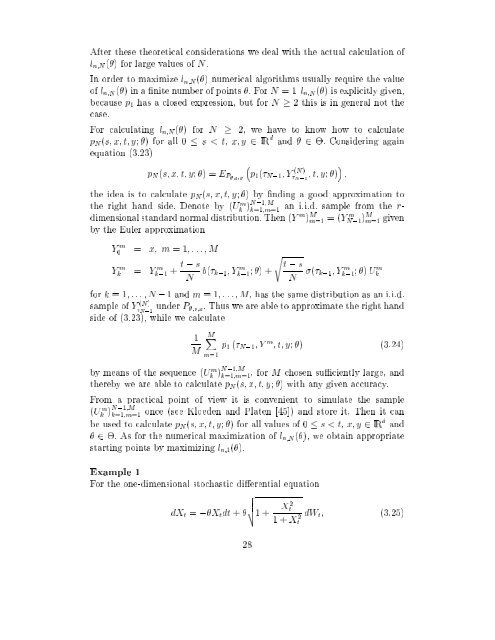Estimation in Financial Models - RiskLab
Estimation in Financial Models - RiskLab
Estimation in Financial Models - RiskLab
Create successful ePaper yourself
Turn your PDF publications into a flip-book with our unique Google optimized e-Paper software.
After these theoretical considerations we deal with the actual calculation of<br />
l n;N () for large values of N.<br />
In order to maximize l n;N () numerical algorithms usually require the value<br />
of l n;N () <strong>in</strong> a nite numberofpo<strong>in</strong>ts . For N =1 l n;N () is explicitly given,<br />
because p 1 has a closed expression, but for N 2 this is <strong>in</strong> general not the<br />
case.<br />
For calculat<strong>in</strong>g l n;N () for N 2, we have to know how to calculate<br />
p N (s; x; t; y; ) for all 0 s < t, x; y 2 IR d and 2 . Consider<strong>in</strong>g aga<strong>in</strong><br />
equation (3.23)<br />
p N (s; x; t; y; ) =E P;s;x<br />
<br />
p1 ( N,1 ;Y (N)<br />
N,1<br />
;t;y; ) ;<br />
the idea is to calculate p N (s; x; t; y; ) by nd<strong>in</strong>g a good approximation to<br />
the right hand side. Denote by (Uk m ) N,1;M<br />
k=1;m=1<br />
an i.i.d. sample from the r-<br />
dimensional standard normal distribution. Then (Y m ) M m=1<br />
=(YN,1) m M m=1<br />
given<br />
by the Euler approximation<br />
Y m<br />
0<br />
= x; m =1;:::;M<br />
Yk m = Y m<br />
k,1<br />
+ t , s<br />
N<br />
b( k,1;Yk,1; m )+<br />
s<br />
t , s<br />
N<br />
( k,1;Y m<br />
k,1; ) U m k<br />
for k =1;:::;N, 1 and m =1;:::;M, has the same distribution as an i.i.d.<br />
sample of Y (N)<br />
N,1<br />
under P ;s;x .Thus we are able to approximate the right hand<br />
side of (3.23), while we calculate<br />
1<br />
M<br />
MX<br />
m=1<br />
p 1 ( N,1 ;Y m ;t;y; ) (3.24)<br />
by means of the sequence (U m k ) N,1;M<br />
k=1;m=1, for M chosen suciently large, and<br />
thereby we are able to calculate p N (s; x; t; y; ) with any given accuracy.<br />
From a practical po<strong>in</strong>t of view it is convenient to simulate the sample<br />
(Uk m ) N,1;M<br />
k=1;m=1<br />
once (see Kloeden and Platen [45]) and store it. Then it can<br />
be used to calculate p N (s; x; t; y; ) for all values of 0 s
















